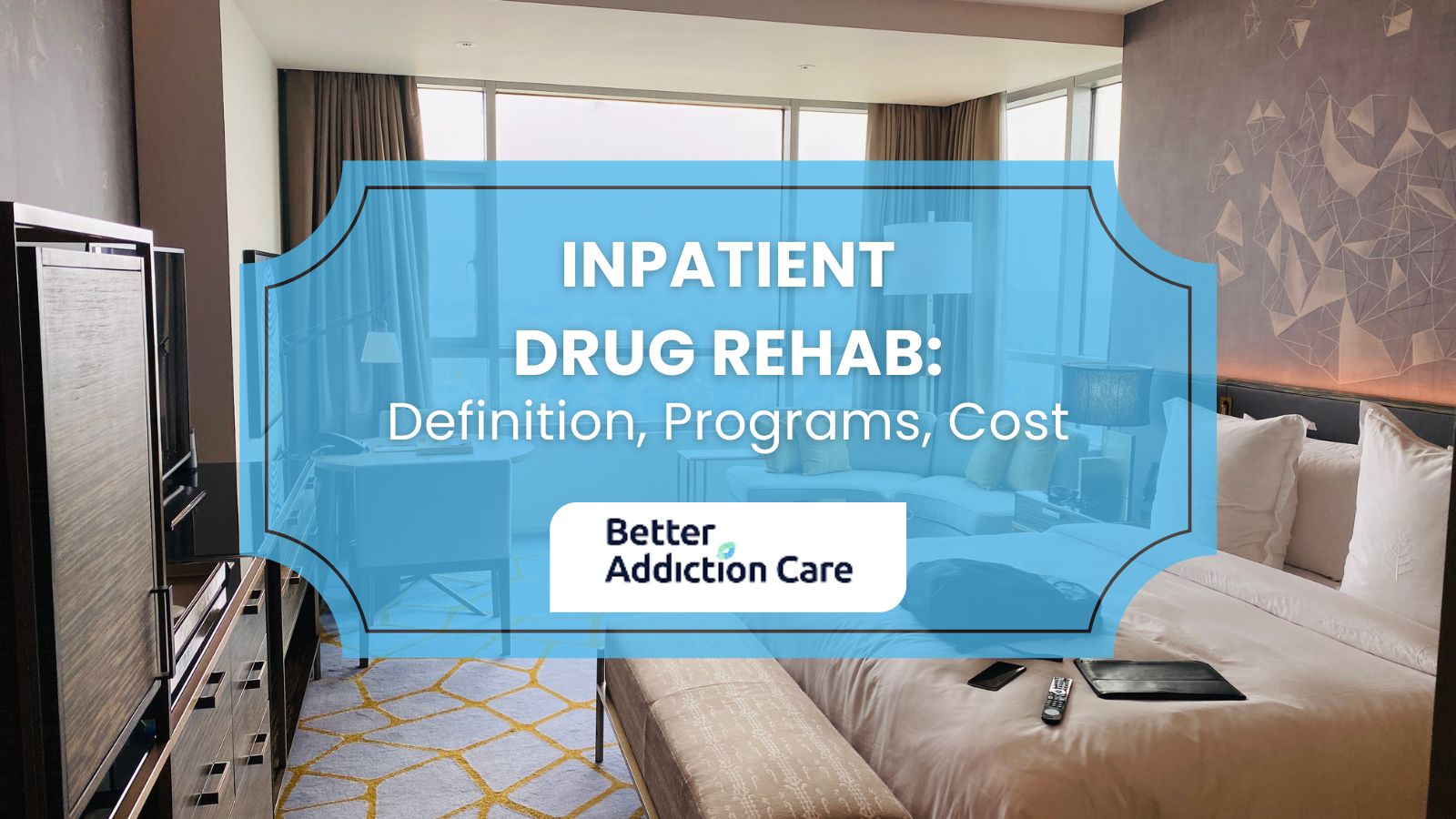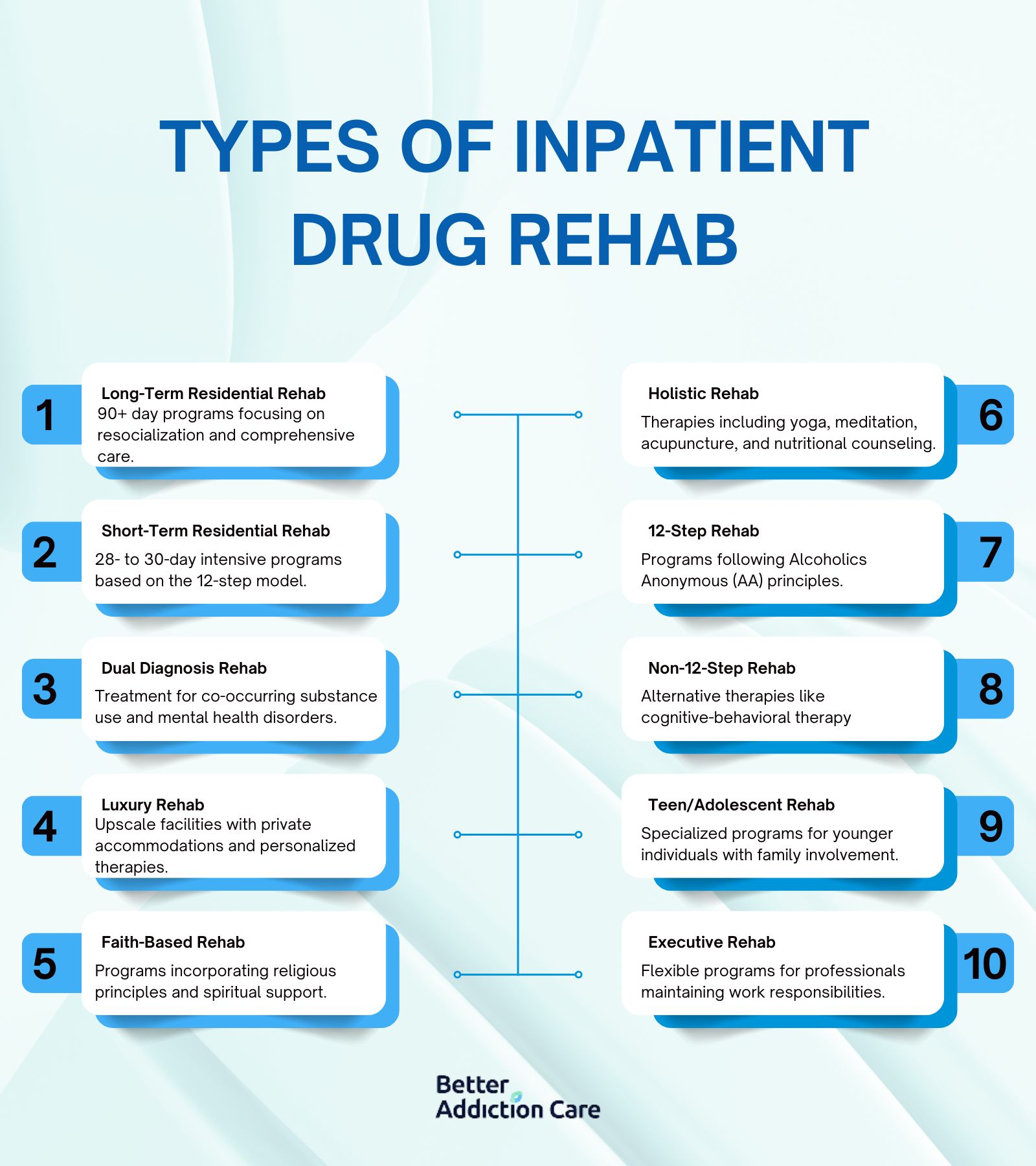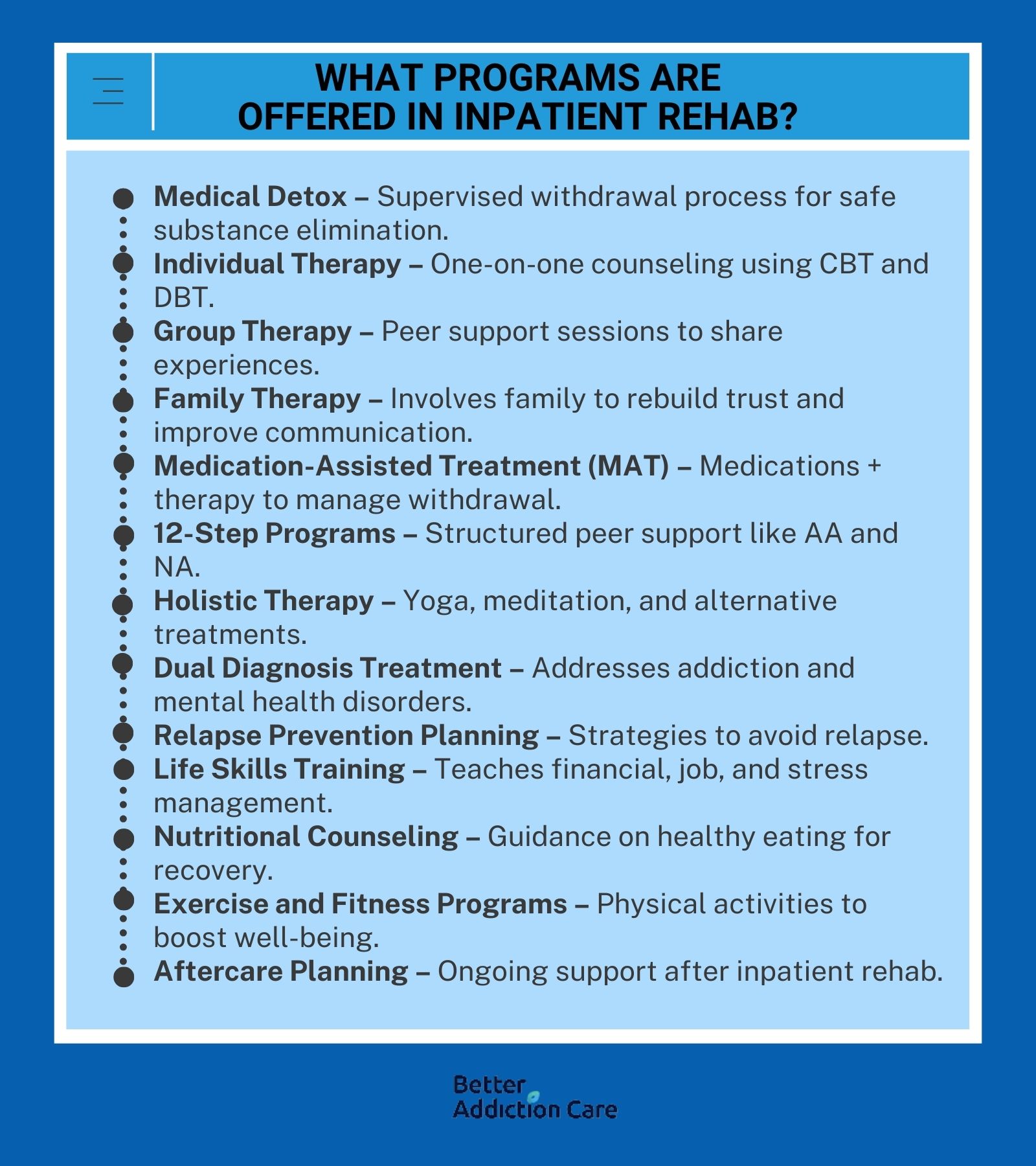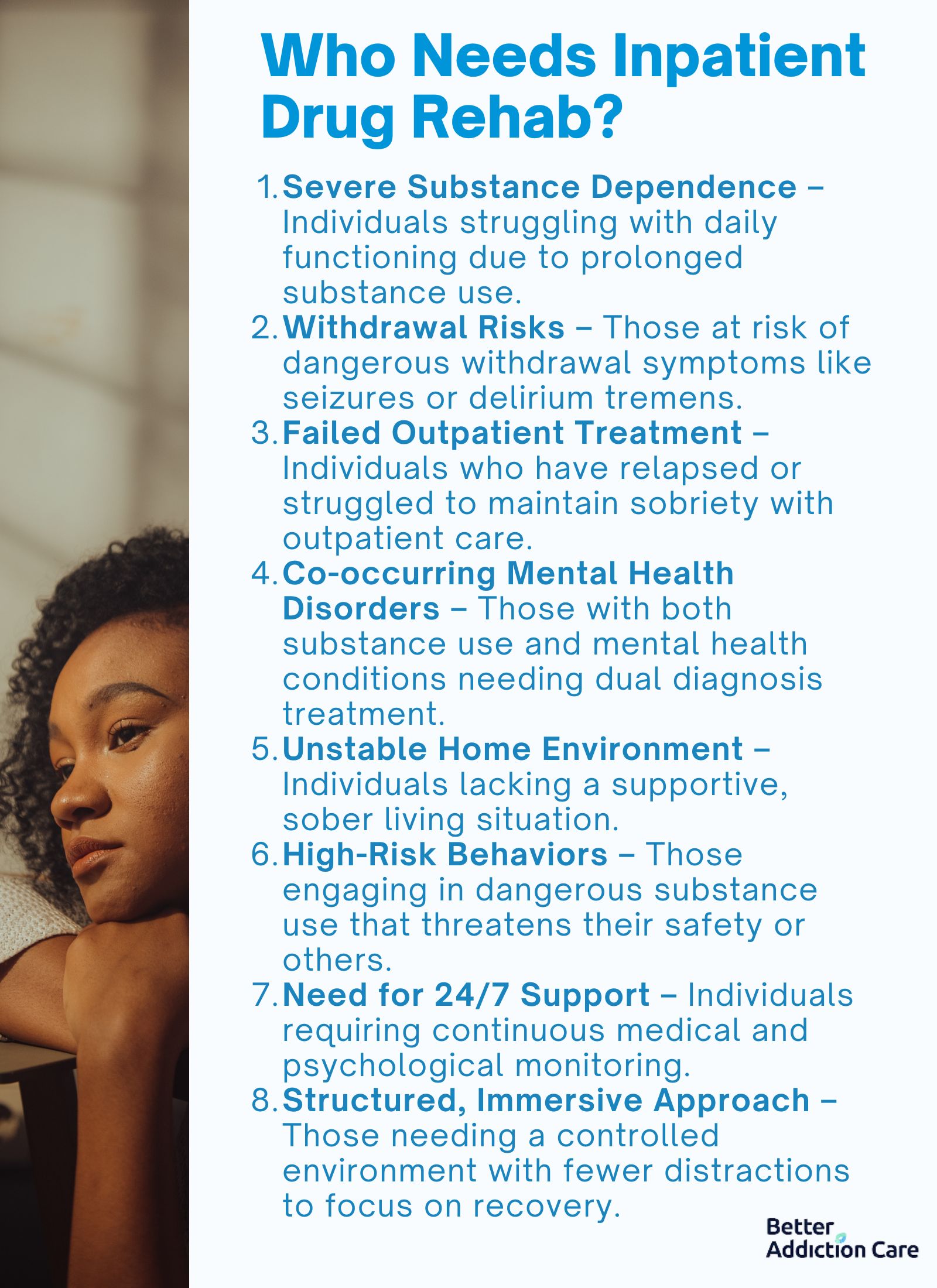Inpatient Drug Rehab: Definition, Programs, Cost
Inpatient drug rehab is an addiction treatment program where individuals stay at a facility to receive intensive care. The purpose of inpatient drug rehab is to provide a controlled environment that removes individuals from triggers, helping them focus on recovery. The growing need for these programs is evident as substance use disorders continue to impact millions, requiring comprehensive interventions that address both physical dependence and psychological factors. According to the 2021 National Survey on Drug Use and Health (NSDUH), approximately 43.7 million individuals aged 12 or older in the United States required treatment for addiction to substances such as alcohol, nicotine, or other drugs. Notably, only about 10% of these individuals, equating to just over 2 million people, received any form of treatment.

Inpatient drug rehab is an addiction treatment program where individuals stay at a facility to receive intensive care. The purpose of inpatient drug rehab is to provide a controlled environment that removes individuals from triggers, helping them focus on recovery. The growing need for these programs is evident as substance use disorders continue to impact millions, requiring comprehensive interventions that address both physical dependence and psychological factors. According to the 2021 National Survey on Drug Use and Health (NSDUH), approximately 43.7 million individuals aged 12 or older in the United States required treatment for addiction to substances such as alcohol, nicotine, or other drugs. Notably, only about 10% of these individuals, equating to just over 2 million people, received any form of treatment.
The main programs in inpatient drug rehab include detox, evidence-based therapies, and specialized care for dual diagnosis. Detox is the first step, ensuring that individuals safely withdraw from substances under medical supervision. Evidence-based therapies such as cognitive behavioral therapy and contingency management help modify behaviors linked to substance use. Individuals with dual diagnosis, which refers to co-occurring mental health disorders and substance use disorders, receive integrated treatment plans that address both conditions at the same time.
The cost of inpatient drug rehab varies based on the facility, length of stay, and level of care. Compared to outpatient and PHP (Partial Hospitalization Programs), inpatient care is more expensive due to 24/7 supervision and comprehensive medical and psychological support. Some facilities accept insurance, while others offer sliding scale fees or financial aid. The financial aspect influences access to addiction rehab programs, making affordability an important consideration for individuals seeking relapse prevention strategies as part of their recovery. According to a study, inpatient rehab costs range from several thousand to tens of thousands of dollars, depending on the program length and amenities provided.
What Is Inpatient Drug Rehab?
Inpatient drug rehab is a type of addiction treatment where individuals stay at a facility to receive medical and psychological care for substance use disorders. These programs provide a structured environment where individuals undergo detox, therapy, and relapse prevention strategies to address the root causes of addiction. The need for inpatient rehab continues to grow as addiction affects millions of people in the United States. According to Liu & Li (2018) in the study "Drug Addiction: A Curable Mental Disorder," substance use disorder is a chronic, relapsing brain disorder that requires comprehensive treatment approaches, including pharmacological interventions, behavioral therapy, and brain stimulation techniques. These findings emphasize the importance of effective rehab programs in managing drug addiction and long-term recovery.
What Are Different Types of Inpatient Drug Rehab?
Different types of inpatient drug rehab programs include long-term residential rehab, short-term residential rehab, and dual diagnosis rehab. These programs provide specialized addiction treatment based on individual needs. These programs require individuals to stay at a treatment facility for a set period, ranging from 28 days to 90 days or longer. According to Wakeman et al. (2017) in the study "Inpatient Addiction Consultation for Hospitalized Patients Increases Post-Discharge Abstinence and Reduces Addiction Severity," inpatient addiction programs improve abstinence rates and reduce addiction severity, demonstrating their importance in long-term recovery. These programs offer various treatment approaches, ensuring that individuals receive care that aligns with their substance use history, mental health status, and personal circumstances.

The different types of inpatient drug rehab are listed below:
-
Long-Term Residential Rehab: Programs lasting 90 days or more focus on resocialization and comprehensive care. These programs provide an immersive environment that helps individuals rebuild life skills and establish long-term recovery strategies.
-
Short-Term Residential Rehab: Intensive programs lasting 28 to 30 days are often based on a modified 12-step rehab model. These programs offer a structured approach to detox, therapy, and relapse prevention.
-
Dual Diagnosis Rehab: Treatment for individuals with both substance use and mental health disorders addresses both conditions simultaneously. According to Wakeman et al. (2017), integrated treatment approaches help reduce addiction severity and improve abstinence outcomes.
-
Luxury Rehab: These facilities provide upscale amenities, private accommodations, and personalized evidence-based therapies. Individuals seeking comfort alongside treatment may choose this option.
-
Faith-Based Rehab: Spirituality plays a role in these programs, incorporating religious principles into addiction treatment. Support often comes from faith communities and religious counseling.
-
Holistic Rehab: Treatment focuses on the whole person, including mind, body, and spirit. Therapies may include yoga, meditation, acupuncture, and nutritional counseling.
-
12-Step Rehab: This program follows the principles of Alcoholics Anonymous and similar recovery groups. Peer support and accountability are key components.
-
Non-12-Step Rehab: Alternative programs use different therapeutic approaches, such as cognitive-behavioral therapy, to help individuals recover without the traditional 12-step model.
-
Teen or Adolescent Rehab: These programs cater to younger individuals, addressing age-specific challenges related to addiction treatment. Therapy often includes family involvement.
-
Executive Rehab: Professionals who need to maintain work responsibilities during treatment receive specialized care. These programs offer flexibility while ensuring recovery remains the priority.
How Does Inpatient Rehab Work?
Inpatient rehab works by providing individuals with addiction treatment in a controlled environment where they receive medical care, evidence-based therapies, and support to help them recover. These programs remove individuals from triggers and provide a daily structure that focuses on healing both the body and mind. Treatment includes detox, counseling, and relapse prevention strategies to address the psychological and physical aspects of addiction. A typical day in inpatient rehab follows a structured schedule designed to promote recovery and stability.
A typical day in inpatient rehab is shown below:
-
Morning Routine: Individuals start the day early with meditation, journaling, or mindfulness exercises. Breakfast is followed by group therapy or an educational session about addiction rehab programs.
-
Therapy Sessions: Evidence-based therapies such as cognitive-behavioral therapy, motivational interviewing, or trauma therapy help individuals develop coping skills. One-on-one counseling sessions allow them to explore personal challenges.
-
Group Support: Group therapy sessions provide peer support, helping individuals share experiences and learn from others. 12-step rehab or non-12-step rehab meetings may be included depending on the facility.
-
Physical Activity: Exercise such as yoga, hiking, or gym workouts is incorporated to improve mental and physical well-being. Holistic rehab approaches may also offer alternative therapies like acupuncture or meditation.
-
Afternoon Therapy: Individuals participate in specialized programs like dual diagnosis rehab, which addresses co-occurring mental health conditions. Relapse prevention education teaches strategies to maintain long-term sobriety.
-
Evening Reflection: After dinner, individuals attend group discussions, 12-step meetings, or family therapy. Journaling, meditation, or personal reflection helps them prepare for the next day.
-
Lights Out: A structured sleep schedule ensures rest and recovery. Maintaining a healthy routine is essential for long-term success in addiction treatment.
What Programs Are Offered in Inpatient Rehab?
The programs offered in Inpatient rehab include detox, therapies and aftercare. Inpatient offers a structured environment where individuals receive comprehensive treatment and support to overcome substance use disorders. These programs address both the physical and psychological aspects of addiction, helping individuals develop coping strategies and long-term recovery skills.

Medical Detox
Medical detox is the first step in inpatient rehab, where individuals undergo a supervised withdrawal process to safely eliminate substances from their system. Doctors and nurses monitor withdrawal symptoms, provide medications when necessary, and ensure a safe and controlled detoxification experience.
Individual Therapy
One-on-one therapy sessions help individuals address the root causes of addiction, such as trauma, stress, or mental health conditions. Therapists use evidence-based approaches like Cognitive Behavioral Therapy (CBT) and Dialectical Behavior Therapy (DBT) to develop coping skills and relapse prevention strategies.
Group Therapy
Group therapy provides a supportive setting where individuals share their experiences, challenges, and successes with others in recovery. Led by a licensed therapist, these sessions help individuals develop communication skills, build peer connections, and reinforce accountability in their sobriety journey.
Family Therapy
Addiction impacts not just the individual but also their loved ones. Family therapy sessions focus on improving communication, rebuilding trust, and educating family members about addiction and recovery. These sessions help create a supportive home environment that promotes long-term sobriety.
Medication-Assisted Treatment (MAT)
MAT combines FDA-approved medications with behavioral therapy to manage withdrawal symptoms and cravings. Medications like methadone, buprenorphine, and naltrexone are commonly used to treat opioid and alcohol dependence, increasing the chances of sustained recovery.
12-Step Programs
Many inpatient rehab centers incorporate 12-step programs like Alcoholics Anonymous (AA) and Narcotics Anonymous (NA) to provide structured peer support. These programs encourage self-reflection, personal accountability, and long-term community support in the recovery process.
Holistic Therapy
Holistic approaches focus on treating the whole person, not just the addiction. Inpatient rehab may include yoga, meditation, acupuncture, art therapy, and mindfulness practices to promote emotional well-being, stress relief, and personal growth.
Dual Diagnosis Treatment
For individuals with co-occurring mental health disorders, dual diagnosis treatment addresses both substance use and underlying conditions such as anxiety, depression, PTSD, or bipolar disorder. A combination of therapy, medication, and psychiatric support helps individuals manage both conditions effectively.
Relapse Prevention Planning
A key component of inpatient rehab is teaching relapse prevention skills to help individuals maintain sobriety after leaving treatment. This involves identifying triggers, developing coping mechanisms, and creating a long-term recovery strategy to reduce the risk of relapse.
Life Skills Training
Life skills programs help individuals regain independence and responsibility by teaching essential skills such as financial management, job readiness, communication, and stress management. These skills improve self-sufficiency and confidence in maintaining a sober lifestyle.
Nutritional Counseling
Substance abuse often leads to poor nutrition and health problems. Nutritional counseling educates individuals on healthy eating habits, meal planning, and the importance of a balanced diet to restore physical health and support mental well-being during recovery.
Exercise and Fitness Programs
Physical activity plays a crucial role in reducing stress, improving mood, and promoting overall health. Inpatient rehab programs often include gym access, personal training, outdoor activities, and structured fitness routines to enhance recovery through movement and discipline.
Aftercare Planning
Successful recovery continues beyond inpatient treatment. Aftercare planning ensures individuals have a structured plan for ongoing support, including outpatient therapy, sober living arrangements, 12-step meetings, and continued medical care. This step helps bridge the gap between rehab and independent living while reducing the risk of relapse.
What Medications Are Used During Inpatient Rehab?
The medications used during inpatient drug rehab are used to manage withdrawal symptoms, reduce cravings, and stabilize individuals during inpatient rehab. These medications help ensure a safer detox process and support long-term recovery by addressing both substance dependence and any underlying mental health conditions.
The medications used during inpatient drug rehab are:
-
Methadone: Used for opioid dependence, helps reduce cravings and withdrawal symptoms.
-
Buprenorphine (Suboxone, Subutex): A partial opioid agonist that minimizes withdrawal effects, often used in microinduction protocols to transition patients from other opioids without triggering withdrawal. According to Ahmed et al. (2020) in the study "Microinduction of Buprenorphine/Naloxone: A Review of the Literature," patients successfully transitioned to buprenorphine using various microdosing techniques over 4 to 8 days.
-
Naltrexone (Vivitrol, Revia): Blocks the effects of opioids and alcohol to prevent relapse.
-
Disulfiram (Antabuse): Creates unpleasant reactions when alcohol is consumed, discouraging drinking.
-
Acamprosate (Campral): Helps restore brain chemistry and reduce alcohol cravings.
-
Benzodiazepines (Diazepam, Lorazepam): Used in alcohol withdrawal to prevent seizures and anxiety.
-
Antidepressants (SSRIs, SNRIs): Prescribed for individuals with co-occurring depression or anxiety to improve mood stability.
-
Antipsychotics (Risperidone, Olanzapine): Helps manage psychosis or severe mental health symptoms. According to Gómez-Revuelta et al. (2020) in the study "Antipsychotic Treatment Effectiveness in First Episode of Psychosis: PAFIP 3-Year Follow-Up Randomized Clinical Trials," olanzapine and risperidone were evaluated for their effectiveness in treating first-episode psychosis over a three-year period.
-
Clonidine: Often used for opioid withdrawal to reduce anxiety, agitation, and high blood pressure.
-
Mood Stabilizers (Lithium, Lamotrigine): Used for individuals with bipolar disorder or mood disorders to regulate emotional fluctuations.
Does Inpatient Drug Rehab Treat Co-Occurring Mental Health Disorders?
Yes, inpatient drug rehab treats co-occurring mental health disorders by offering integrated treatment that addresses both substance use and underlying psychiatric conditions. According to the 2011 U.S. National Survey on Drug Use and Health, approximately 17.5% of adults with a mental illness also had a co-occurring substance use disorder, equating to about 7.98 million individuals. Many individuals struggling with addiction also experience disorders such as depression, anxiety, PTSD, or bipolar disorder, which require specialized care. Inpatient programs provide psychiatric evaluations, medication management, and evidence-based therapies like Cognitive Behavioral Therapy (CBT) and Dialectical Behavior Therapy (DBT) to help individuals manage both conditions simultaneously. This comprehensive approach improves recovery outcomes and reduces the risk of relapse by treating the root causes of addiction.
Who Needs Inpatient Drug Rehab?
Inpatient drug rehab is necessary for individuals who require a highly structured and supervised environment to overcome substance use disorders. According to the National Survey of Substance Abuse Treatment Services (N-SSATS) conducted by the Substance Abuse and Mental Health Services Administration (SAMHSA), in 2020, there were 1,456,300 clients enrolled in substance abuse treatment facilities across the United States. The inpatient level of care is ideal for those experiencing severe addiction, withdrawal risks, or co-occurring mental health conditions.

The people who need inpatient drug rehab are:
-
Individuals with severe substance dependence: Those who struggle with daily functioning due to prolonged substance use require intensive medical and psychological care.
-
People at risk of dangerous withdrawal symptoms: Those experiencing withdrawal complications, including seizures or delirium tremens, need supervised detoxification in a medical setting.
-
Those with multiple failed attempts at outpatient treatment: Individuals who have relapsed frequently or struggled with maintaining sobriety may need a structured inpatient environment.
-
Individuals with co-occurring mental health disorders: Those requiring dual diagnosis treatment benefit from inpatient care that addresses both substance use and mental health conditions.
-
People lacking a stable, supportive home environment: Individuals without a sober, structured living situation often struggle with maintaining recovery in outpatient settings.
-
Individuals engaging in high-risk behaviors: Those using substances in ways that endanger their safety or others may require inpatient supervision.
-
Those needing 24/7 medical and psychological support: Individuals who require continuous monitoring benefit from inpatient rehab intensive care.
-
People seeking a structured, immersive approach: Those who need fewer distractions and a controlled setting to focus fully on addiction treatment may thrive in inpatient rehab.
How Much Does Inpatient Rehab Cost?
The cost of inpatient rehab ranges from $5,000 to $20,000 for a 30-day stay at a standard facility, while luxury or long-term programs can cost $30,000 to over $100,000. The total expense depends on location, level of care, amenities, and insurance coverage. Some state-funded and nonprofit rehab centers offer free or low-cost treatment for those who qualify. Private insurance, Medicaid, and Medicare cover some or all expenses, with costs varying based on in-network or out-of-network status. Understanding treatment pricing and insurance options helps individuals navigate financial planning for addiction recovery.
How Does Insurance Work for Inpatient Rehab Treatment?
Health insurance works for inpatient rehab treatment by covering a portion or all of the costs associated with inpatient rehab, depending on the policy and provider. Many plans under Medicaid, Medicare, private insurance, and employer-sponsored plans include coverage for addiction treatment under the Mental Health Parity and Addiction Equity Act (MHPAEA). Coverage includes detox, inpatient stays, therapy, and medication-assisted treatment, but individuals are responsible for copays, deductibles, or out-of-network costs. Checking with an insurance provider and the rehab facility is crucial to understanding coverage options.
Are There Payment Plans Available for Inpatient Rehab?
Yes, there are payment plans for inpatient rehab in order to help individuals afford treatment. Payment options include monthly installment plans, sliding-scale fees based on income, scholarships, or financing programs. Some rehab facilities partner with third-party lenders to provide low-interest or no-interest financing options. Additionally, nonprofits, grants, and state-funded programs may assist individuals who cannot afford private rehab. Discussing payment options with the rehab facility can help determine the best financial solution for treatment.
What Factors Affect the Cost of Inpatient Rehab?
The factors that affect the cost of inpatient rehab include length of stay, level of care, location, and amenities provided. Facilities offering private rooms, luxury accommodations, or specialized treatment programs have higher costs than standard rehab centers. Additional expenses come from medical detox, medication-assisted treatment (MAT), dual diagnosis care, and aftercare planning. Insurance coverage and whether the facility is in-network or out-of-network also determine the total cost of treatment.
Below is a breakdown of how each factor influences the overall cost:
-
Length of Stay: Longer stays require more resources, including housing, meals, therapy, and medical supervision, leading to higher costs.
-
Level of Care: Facilities offering intensive medical supervision or specialized dual diagnosis care charge more due to the need for additional staff and resources.
-
Location: Rehabs in major cities or sought-after areas typically have higher costs due to demand and operational expenses.
-
Amenities Provided: Luxury rehab centers with private rooms, spa treatments, and holistic therapies cost more than standard treatment facilities.
-
Medical Detox: Programs requiring detox services increase costs, especially when medical monitoring and medication management are necessary.
-
Medication-Assisted Treatment (MAT): The use of FDA-approved medications, such as buprenorphine or methadone, adds to treatment costs.
-
Insurance Coverage: The total cost depends on whether the facility is in-network or out-of-network, as insurance plans vary in coverage.
-
Aftercare Planning: Extended support services, such as sober living homes or outpatient therapy, add to the overall cost of rehab.
Are There Free or Low-Cost Inpatient Rehab Options?
Yes there are free and low-cost inpatient rehab options through state-funded programs, nonprofit organizations, and sliding-scale payment plans. Government-funded facilities provide reduced-cost or free treatment based on income level or financial hardship. Medicaid, Medicare, and certain grants cover inpatient rehab for eligible individuals. Nonprofit rehab centers and faith-based programs also provide affordable treatment options.
Does Medicare or Medicaid Cover Inpatient Rehab?
Yes medicare and medicaid cover inpatient rehab services, but eligibility and benefits vary by state. Medicare Part A covers hospital-based inpatient rehab, including detox, therapy, and medical care, while Medicare Part B includes outpatient services following rehab. Medicaid provides coverage for inpatient addiction treatment for qualifying low-income individuals, including detox and therapy. Coverage limits, copays, and length of stay restrictions apply, so verifying with the insurance provider and rehab facility is necessary.
How to Find An Inpatient Drug Rehab Near Me?
To find an inpatient drug rehab near you, research the different types of inpatient rehabs in your state. You can use websites and online directories to find a rehab locator for your state. These tools help you narrow down the type of treatment you are looking for and give you multiple options of listings that also include the number you should call to get more information and a verification of benefits.
Can the State Require Inpatient Rehab?
Yes the state can mandate inpatient rehab in situations where an individual poses a danger to themselves or others due to substance use. Court-ordered rehab applies to individuals arrested for drug-related offenses, placed under involuntary commitment laws, or deemed unfit to make decisions about their care. As of 2022, there are over 3,000 drug courts operating across the United States, handling approximately 120,000 individuals annually. These programs have been associated with significant cost savings, with studies indicating average savings ranging from nearly $3,000 to over $12,000 per client according to the Washington State Institute for Public Policy.. Laws like the Marchman Act in Florida allow family members or medical professionals to petition for involuntary substance abuse treatment when a person refuses help but remains at risk.
What Is the Difference Between Inpatient and Outpatient Drug Rehab?
The main difference between inpatient and outpatient drug rehab is that inpatient is residential and outpatient, the patient lives at home. Inpatient drug rehab provides 24/7 care in a structured, residential setting, where individuals stay at the facility for the duration of treatment. This approach offers medical supervision, therapy, and support in an environment free from outside distractions or triggers. Outpatient drug rehab allows individuals to live at home while attending scheduled treatment sessions, offering more flexibility for those who need to continue working, attending school, or fulfilling family obligations. Inpatient rehab is best suited for individuals with severe addiction, co-occurring disorders, or those needing medical detox, while outpatient rehab works for those with mild to moderate addiction and a stable home environment.
What to Bring to Inpatient Drug Rehab?
Things to bring to inpatient rehab include comfortable clothing, toiletries without alcohol-based ingredients, prescription medications in original packaging, and personal items for relaxation and reflection. Bringing items that support mental and emotional well-being, such as a journal, books, or family photos, helps ease the transition. Prohibited items often include electronics, outside food, and unapproved medications, ensuring a distraction-free and safe environment.
Recommended Items:
-
Comfortable clothing suited for daily activities and weather
-
Personal hygiene products (alcohol-free and non-aerosol)
-
Prescription medications in original bottles with documentation
-
Notebook or journal for reflection and personal growth
-
Books or reading materials focused on motivation or spirituality
-
Family photos or small personal items for emotional support
-
A list of emergency contacts and insurance details
-
Recovery-related materials such as 12-step literature if permitted
Prohibited Items:
-
Electronics (phones, laptops, tablets) unless allowed by the facility
-
Outside food and beverages
-
Drugs, alcohol, or paraphernalia
-
Unapproved over-the-counter medications
-
Weapons or potentially dangerous objects
-
Excessive amounts of cash or valuables
Each facility has specific rules, so verifying the allowed and prohibited items beforehand helps ensure a smooth admission process.
How Long Is Inpatient Drug Rehab?
The length of inpatient drug rehab varies based on individual needs, treatment progress, and facility programs. Standard treatment durations include 30, 60, or 90 days, with extended programs lasting six months to a year for those requiring long-term support. Detox typically lasts a few days to a week, followed by intensive therapy and recovery planning. Longer stays increase the likelihood of sustained sobriety, as they allow more time for habit formation, therapy, and relapse prevention strategies.
What Happens After Inpatient Drug Rehab?
After completing inpatient drug rehab, individuals transition to aftercare programs that support long-term recovery. Options include outpatient treatment, sober living homes, 12-step meetings, individual therapy, and relapse prevention planning. Many continue medication-assisted treatment (MAT) or counseling to manage triggers, stress, and co-occurring disorders. Structured aftercare provides accountability, helping individuals maintain sobriety and successfully reintegrate into daily life.





